Eco-Innovation Analyses in the Management of Drinking Water Provided by the Main Suppliers in Romania
Abstract
1. Introduction
- Inputs in the field of eco-innovation;
- Eco-innovation activities;
- Eco-innovation results;
- A specific indicator regarding the requirements of the performed study;
- Socio-economic results;
- Resources efficiency.
2. Analytical Framework of the Concept of Eco-Innovation in the Water Management Sector
2.1. Water Management Framework
- -
- Accessible and high-quality fresh water is a limited and highly variable resource. OECD projections show that 40% of the world’s population currently lives in river basins, which is why water demand will increase up to 55% by 2050.
- -
- By 2050, 240 million people are expected to be without access to clean water and 1.4 billion are expected to be without access to basic sanitation.
- -
- Significant investment is needed to renew and modernize infrastructure, estimated at $ 6.7 trillion by 2050 for water supply and sanitation, while the inclusion of a wider range of related infrastructure could triple the amount of investment required by 2030 [8]. Water management can greatly contribute to the development and implementation of sound public policies, with a shared responsibility between different levels of government, civil society, businesses, and the full range of stakeholders along with other decision makers who play an important role in achieving the environmental benefits of good water governance.
- -
- assessing the contribution of operational programs to the implementation of EU water policy;
- -
- providing key descriptive statistics on the consideration of water issues in rural development programs 2014–2020;
- -
- developing guidelines for the development of a good practices from a water perspective.
- -
- step up efforts by member states to fully implement EU water legislation;
- -
- launch a public consultation at EU level on the Drinking Water Directive to assess the need for improvements and how they could be achieved;
- -
- improve citizen information by further developing efficient and more transparent management and dissemination of data on domestic and drinking water;
- -
- explore the idea of benchmarking water quality;
- -
- promote a structured dialogue between stakeholders on transparency in the water sector;
- -
- cooperate with existing initiatives to provide a broader set of benchmarks for water services, improving the transparency and accountability of water service providers, giving citizens access to comparable data on key economic and quality indicators;
- -
- stimulate innovative approaches to development assistance (e.g., support partnerships between water operators and public–private partnerships) and promote best practices between member states (e.g., on solidarity instruments);
- -
- promote universal access to drinking water and sanitation as a priority area for the post-2015 sustainable development objectives;
- -
- finally, call on member states, acting within the limits of their competences, to take into account the concerns of citizens through this initiative and to encourage them to step up their efforts to ensure safe, ecological, and accessible water supply for all.
2.2. Romania Versus the EU Regarding General Indicators from the Eco-Innovation Field
2.3. Eco-Innovation, a Mechanism towards Sustainability
- Environmental technologies—comprising technologies used to limit and control the pollution emitted and technologies that limit the use of resources and materials in production;
- Organizational innovation—a new environmental management based on the concept of life cycle assessment as well as on cooperation between organizations;
- Innovation of products and services—including changes in the design and generation of products or services;
- Green system innovation—the use of alternative production and consumption systems, more environmentally friendly than those used so far.
3. Materials and Methods Used in the Research
3.1. Description of the Research and Specific Objectives Pursued
- Identification of economic operators—drinking water suppliers in Romania;
- Identification and establishment of indicators used in the evaluation of economic operators;
- Realization of a value scale based on the figures obtained by each economic operator in the field of eco-innovation;
- Implementation of a comparative analysis between the economic operators, based on the established indicators;
- Interpretation of final results.
Identification of Economic Operators—Drinking Water Suppliers in Romania
3.2. Identifying and Establishing the Indicators Used in the Evaluation of Economic Operators
- From Region 1 (Northwest Region)—Satu Mare, Cluj-Napoca, Oradea;
- From Region 2 (West Region)—Timișoara, Arad;
- From Region 3 (Southwest Region)—Craiova;
- From Region 4 (South Region)—București, Ploiești, Pitești;
- From Region 5 (Southeast Region)—Galați, Tulcea;
- From Region 7 (Northeast Region)—Iași, Suceava;
- From Region 8 (Center Region)—Alba Iulia, Sibiu, Brașov.
3.3. Case Study on Performing a Comparative Analysis between Economic Operators
- Operators with high performance in eco-innovation: 4–5 points;
- Operators with average performance in eco-innovation who had to improve certain aspects: 2–3 points;
- Operators with poor performance in eco-innovation who meet the minimum criteria: 0–1 points;
4. Results and Discussion
- -
- The category of high scores, obtained by the Northwest Region;
- -
- The category of average scores, which included the Southern, Center, and Western Regions;
- -
- The category of minimum scores, in which fell the Southeast, Southwest and Northeast Regions.
- ➢
- Descending ordering of the analyzed elements (distribution of regional operators’ scores based on established indicators);
- ➢
- Calculation of the relative cumulative frequency of eco-innovation scores obtained by the regional operators;
- ➢
- Graphic tracing of the columns corresponding to each analyzed element (score value);
- Category “A” comprises 20% of the total scores assigned to eco-innovation indicators, consisting of the first indicator analyzed (I 2), which is thus the most respected criterion by regional operators and is therefore the most important one.
- Category “B” comprises 30% of the total scores assigned to eco-innovation indicators, consisting of 2 indicators (I 1 and I 4), these having random occurrences and medium influence in the order of importance for compliance by regional operators.
- Category “C” comprises 50% of the total scores assigned to eco-innovation indicators, consisting of the other 6 indicators, which have a low incidence rate among regional operators.
5. Conclusions
Author Contributions
Funding
Institutional Review Statement
Informed Consent Statement
Data Availability Statement
Conflicts of Interest
Appendix A
| No. | Operator Code Name |
|---|---|
| 1. | C 1 C.T.T.A. |
| 2. | C 2 A.C. 2000 |
| 3. | C 3 C.A.A. |
| 4. | C 4 C.R.A.B. |
| 5. | C 5 C.A.O |
| 6. | C 6 A.C.N.V. |
| 7. | C 7 A.B.N. |
| 8. | C 8 C.U.P.D. |
| 9. | C 9 C.A.B. |
| 10. | C 10 N.A.B |
| 11. | C 11 C.D.A.B. |
| 12. | C 12 A.N.B |
| 13. | C 13 E.C. |
| 14. | C 14 C.A.S.C.N. |
| 15. | C 15 C.A.A.T. |
| 16. | C 16 A.C.R. |
| 17. | C 17 R.C. |
| 18. | C 18 G.C.S.G. |
| 19. | C 19 C.A.T.D. |
| 20. | C 20 C.A.O. |
| 21. | C 21 A.C.G. |
| 22. | C 22 A.S.G. |
| 23. | C 23 A.P.D. |
| 24. | C 24 A.S.V.J. |
| 25. | C 25 H.M.C. |
| 26. | C 26 A.C.I. |
| 27. | C 27 E.A.V. |
| 28. | C 28 A.I. |
| 29. | C 29 S.D.T.S. |
| 30. | C 30 V.B.M. |
| 31. | C 31 C.A.T.M. |
| 32. | C 32 C.J.A.S.N. |
| 33. | C 33 C.A.O.S. |
| 34. | C 34 A.N.P. |
| 35. | C 35 H.P.P. |
| 36. | C 36 A.C.S. |
| 37. | C 37 A.T.M.M. |
| 38. | C 38 A.S.M. |
| 39. | C 39 A.S. |
| 40. | C 40 A.T. |
| 41. | C 41 A.S.A. |
| 42. | C 42 S.A.T. |
| 43. | C 43 A.R.V. |
| 44. | C 44 A.C.T.J. |
| 45. | C 45 C.U.P.F. |
| 46. | C 46 A.V. |

References
- Guo-Gang, J. Empirical Analysis of Regional Circular Economy Development—Study Based on Jiangsu, Heilongjiang, Qinghai Province. Energy Procedia 2011, 5, 125–129. [Google Scholar] [CrossRef]
- Andersen, M.S. An introductory note on the environmental economics of the circular economy. Sustain. Sci. J. 2007, 2, 133–140. [Google Scholar] [CrossRef]
- Sariatli, F. Linear Economy Versus Circular Economy: A Comparative and Analyzer Study for Optimization of Economy for Sustainability. J. Bioeconomy Sustain. Dev. 2017, 1, 31–34. [Google Scholar] [CrossRef]
- What Is the Linear Economy and Why Do We Need To Go Circular? Available online: https://res.mdpi.com/data/mdpi_references_guide_v5.pdf (accessed on 7 May 2021).
- Dezvoltarea Sustenabilă a Întreprinderii—Primul Pas Spre Dezvoltarea Durabilă. Available online: http://steconomiceuoradea.ro/anale/volume/2006/economie-si-administrarea-afacerilor/9.pdf (accessed on 9 October 2020).
- Terence, T.; Mark, E.; Khaled, S. Fast-Expanding Markets: The Revolution of the Microeconomy. Thunderbird Int. Bus. Rev. J. 2016, 58, 5–11. [Google Scholar]
- Machiba, T. Eco-innovation for enabling resource efficiency and green growth: Development of an analytical framework and preliminary analysis of industry and policy practices. J. Int. Econ. Econ. Policy 2010, 7, 357–370. [Google Scholar] [CrossRef]
- Final Report MEI Project about Measuring Ecoinnovation. Available online: https://www.oecd.org/env/consumption-innovation/43960830.pdf (accessed on 2 March 2021).
- Country Profiles. Available online: https://ec.europa.eu/environment/ecoap/country_profiles_en (accessed on 2 March 2021).
- Eco-Innovation Observatory. Available online: https://www.eco-innovation.eu/countries (accessed on 2 March 2021).
- OECD Principles of Water Governance. Available online: http://www.oecd.org/cfe/regionaldevelopment/OECD-Principles-on-Water-Governance.pdf (accessed on 3 October 2020).
- Beatrice, H. Criteria for the assessment of processes for sustainable river basin management and their congruence with the EU Water Framework Directive. Environ. Policy Gov. J. 2008, 18, 228–242. [Google Scholar]
- EU Water Framework Directive. Available online: https://www.pianc.org/eu-water-framework-directive (accessed on 26 December 2020).
- European Commission—Water Framework Directive. Available online: https://ec.europa.eu/environment/water/index_en.htm (accessed on 6 October 2020).
- Slovenia Adds Water to Constitution as Fundamental Right for All. Available online: https://www.theguardian.com/environment/2016/nov/18/slovenia-adds-water-to-constitution-as-fundamental-right-for-all (accessed on 7 October 2020).
- Commision Says Yes to First Successful European Citizens’ Initiative. Available online: https://ec.europa.eu/commission/presscorner/detail/en/IP_14_277 (accessed on 7 October 2020).
- The New Plastics Economy: Rethinking the Future of Plastics. Available online: https://www.ellenmacarthurfoundation.org/publications/the-new-plastics-economy-rethinking-the-future-of-plastics (accessed on 8 October 2020).
- Eco-Inovarea Crește Competitivitatea Companiilor. Available online: https://www.green-report.ro/eco-inovarea-creste-competitivitatea-companiilor/ (accessed on 17 November 2020).
- Ekins, P. Eco-Innovation for Environmental Sustainability: Concepts, Progress and Policies. Int. Econ. Econ. Policy J. 2010, 7, 267–290. [Google Scholar] [CrossRef]
- Stahel, W.R. The business angle of a circular economy. Higher competitiveness, higher resource security and material efficiency. In A New Dynamic. Effective Business in a Circular Economy; Ellen MacArthur Foundation: Cowes, UK, 2014. [Google Scholar]
- Boons, F.; Montalvo, C.; Quist, J.; Wagner, M. Sustainable innovation, business models and economic performance: An overview. J. Clean. Prod. 2013, 45, 1–8. [Google Scholar] [CrossRef]
- Ecoinovarea, Cheia Competitivității Europei în Viitor. Available online: https://ec.europa.eu/environment/pubs/pdf/factsheets/ecoinnovation/ro.pdf (accessed on 12 November 2020).
- Eco-Innovation Observatory. Available online: https://www.eco-innovation.eu/index.php/eco-innovation-index (accessed on 12 November 2020).
- Kuo, T.-C.; Smith, S. A systematic review of technologies involving eco-innovation for enterprises moving towards sustainability. J. Clean. Prod. 2018, 192, 209. [Google Scholar] [CrossRef]
- He, F.; Miao, X.; Wong, C.W.; Lee, S. Contemporary corporate eco-innovation research: A systematic review. J. Clean. Prod. 2018, 174, 503. [Google Scholar] [CrossRef]
- Kemp, R.; Volp, M. The diffusion of clean technologies: A review with suggestions for future diffusion analysis. J. Clean. Prod. 2008, 16, 14–21. [Google Scholar] [CrossRef]
- Ce Înseamnă Operator Regional? Available online: https://www.vitalmm.ro/ro/intrebari-frecvente/ce-inseamna-operator-regional (accessed on 13 November 2020).
- Autoritate Națională de Reglementare pentru Serviciile Comunitare de Utilități Publice—Avizare Prețuri. Available online: https://www.anrsc.ro/avizare-preturi/ (accessed on 13 November 2020).
- Law 241/2006 on the Water Supply and Sewerage Service, Published in the Official Gazette of Romania, Part I, no. 570 of. 30 July 2015. Available online: http://legislatie.just.ro/Public/DetaliiDocument/73044 (accessed on 14 November 2020).
- The Map for Development Regions from Romania. Available online: http://www.freecountrymaps.com/map/country/romania-map-ro/outline-maps/ (accessed on 7 May 2021).
- DEX: Indicator. Available online: https://dexonline.ro/definitie/indicator (accessed on 14 November 2020).
- Key Performance Indicators. Available online: https://www.learningnetwork.ro/articol/ce-sunt-kpis/1183 (accessed on 15 November 2020).
- Scott, J.T. The Sustainable Business a Practitioner’s Guide to Achieving Long-Term Profitability and Competitiveness, 2nd ed.; Greenleaf Publishing: Sheffield, UK, 2015; ISBN -13:978-1906093839. [Google Scholar]
- RENAR. Available online: https://www.renar.ro/ (accessed on 2 March 2021).
- ANRSC. Available online: https://www.anrsc.ro/front-page-apa-si-canalizare/ (accessed on 2 March 2021).
- The Entropy Law and the Economic Process in Retrospect. Available online: http://college.holycross.edu/eej/Volume12/V12N1P3_25.pdf (accessed on 16 November 2020).
- Swamidass, P.M. Pareto Chart. Encyclopedia of Production and Manufacturing Management; Springer: New York, NY, USA, 2000; pp. 508–2000. [Google Scholar]
- The Eco-Innovation Scoreboard and the Eco-Innovation Index. Available online: https://ec.europa.eu/environment/ecoap/indicators/index_en (accessed on 20 November 2020).
- Bisgaard, Tanja, Tuck, Katie, The Business Case for Eco-Innovation, United Nations Environment Programme. Available online: https://www.academia.edu/12448708/The_Business_Case_for_Eco_Innovation (accessed on 22 November 2020).
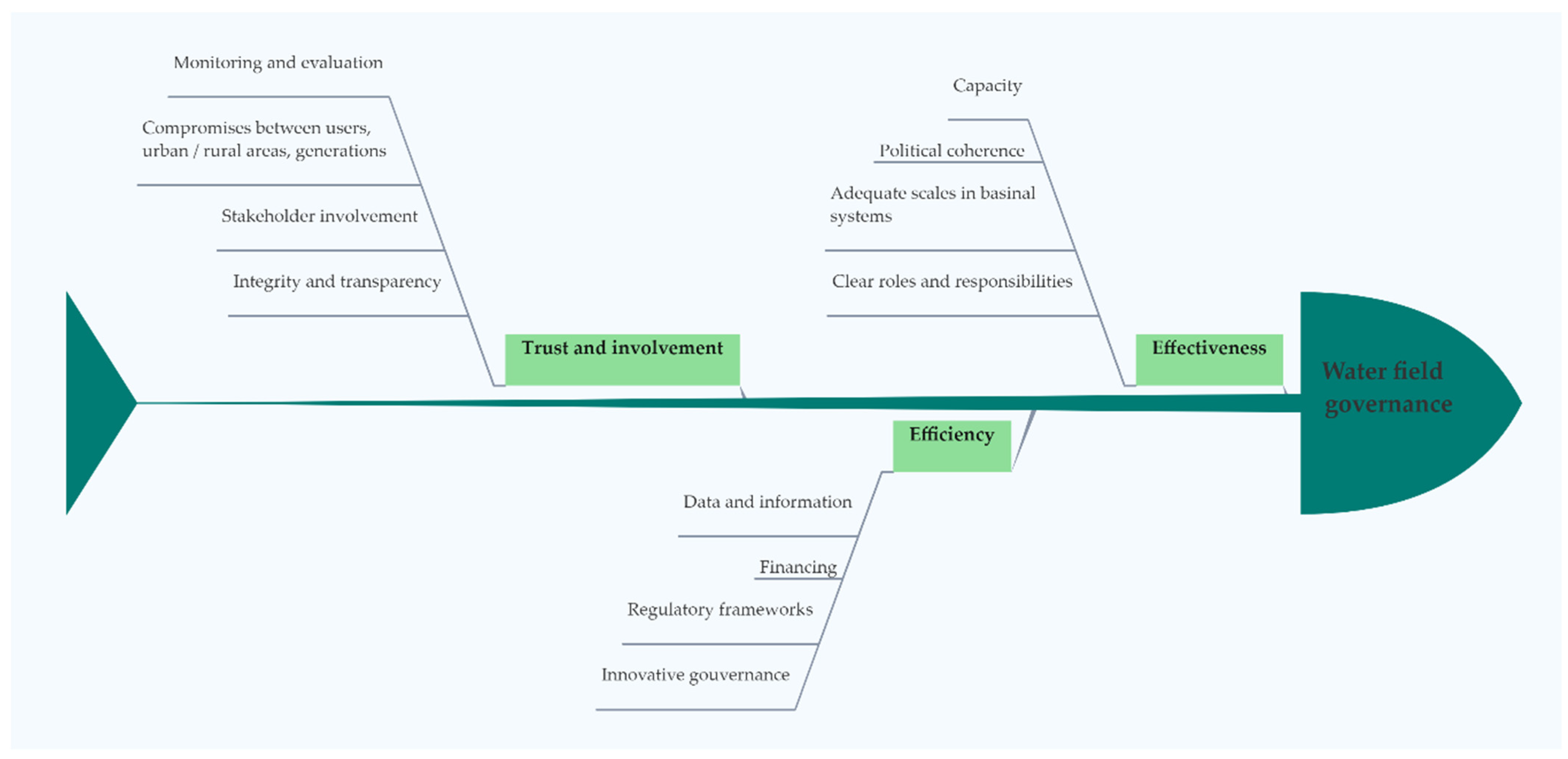
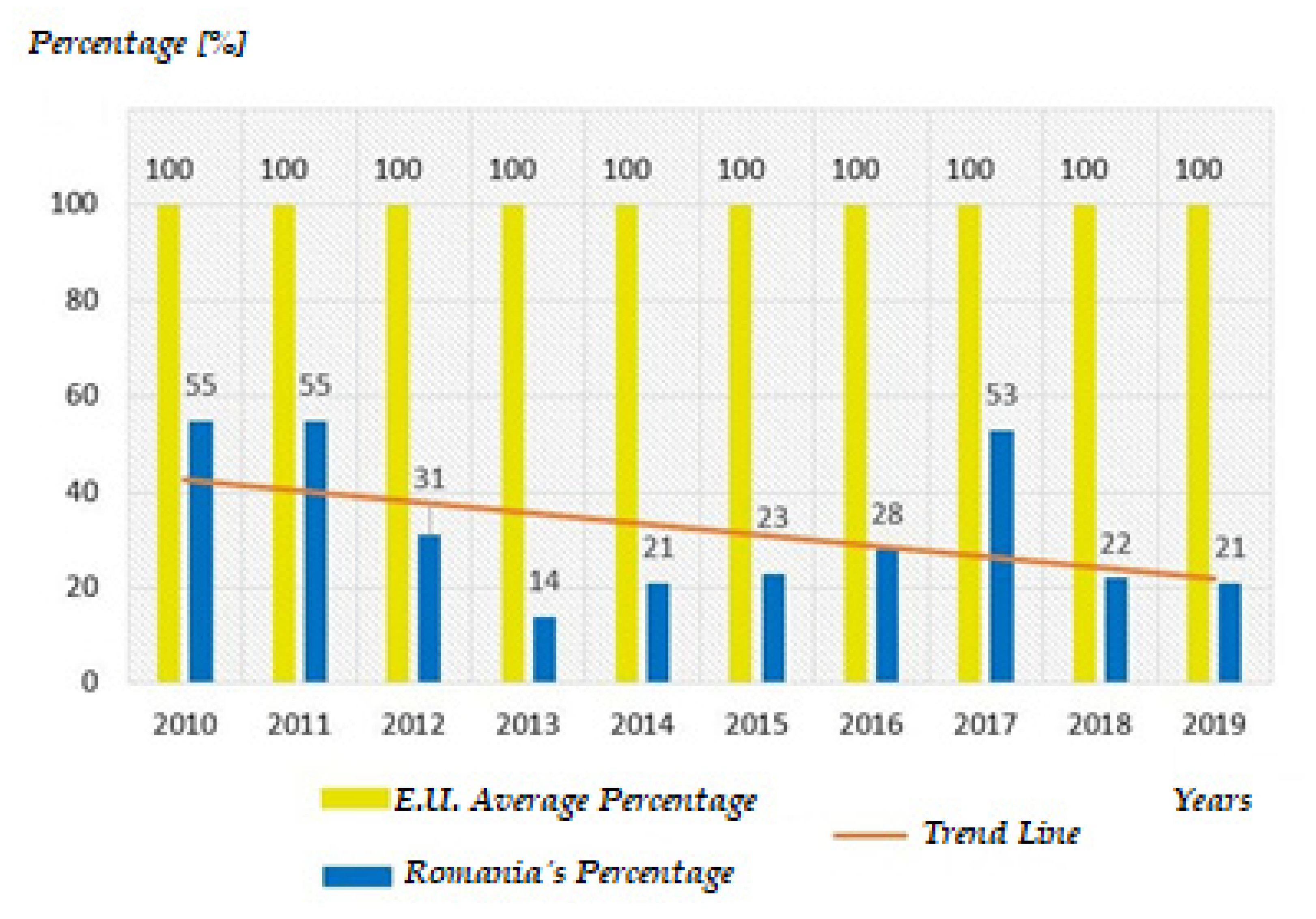
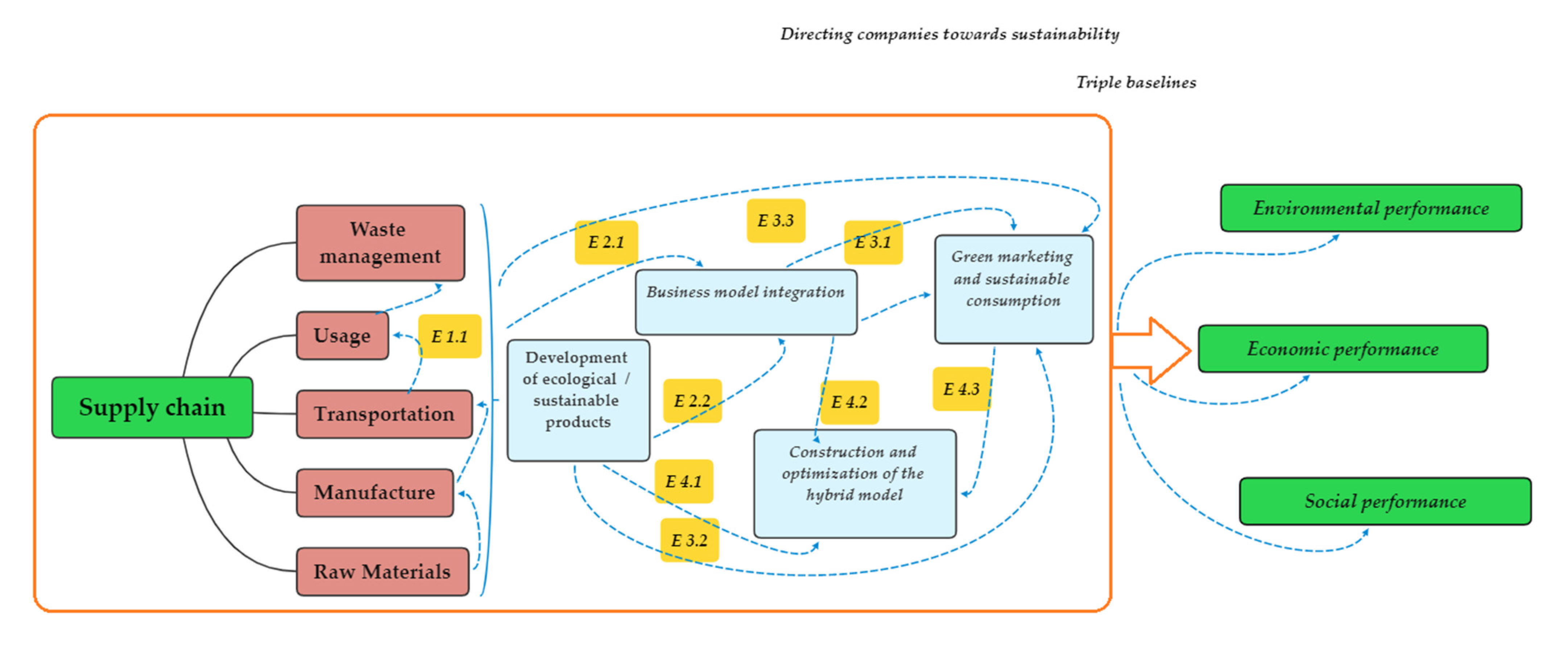
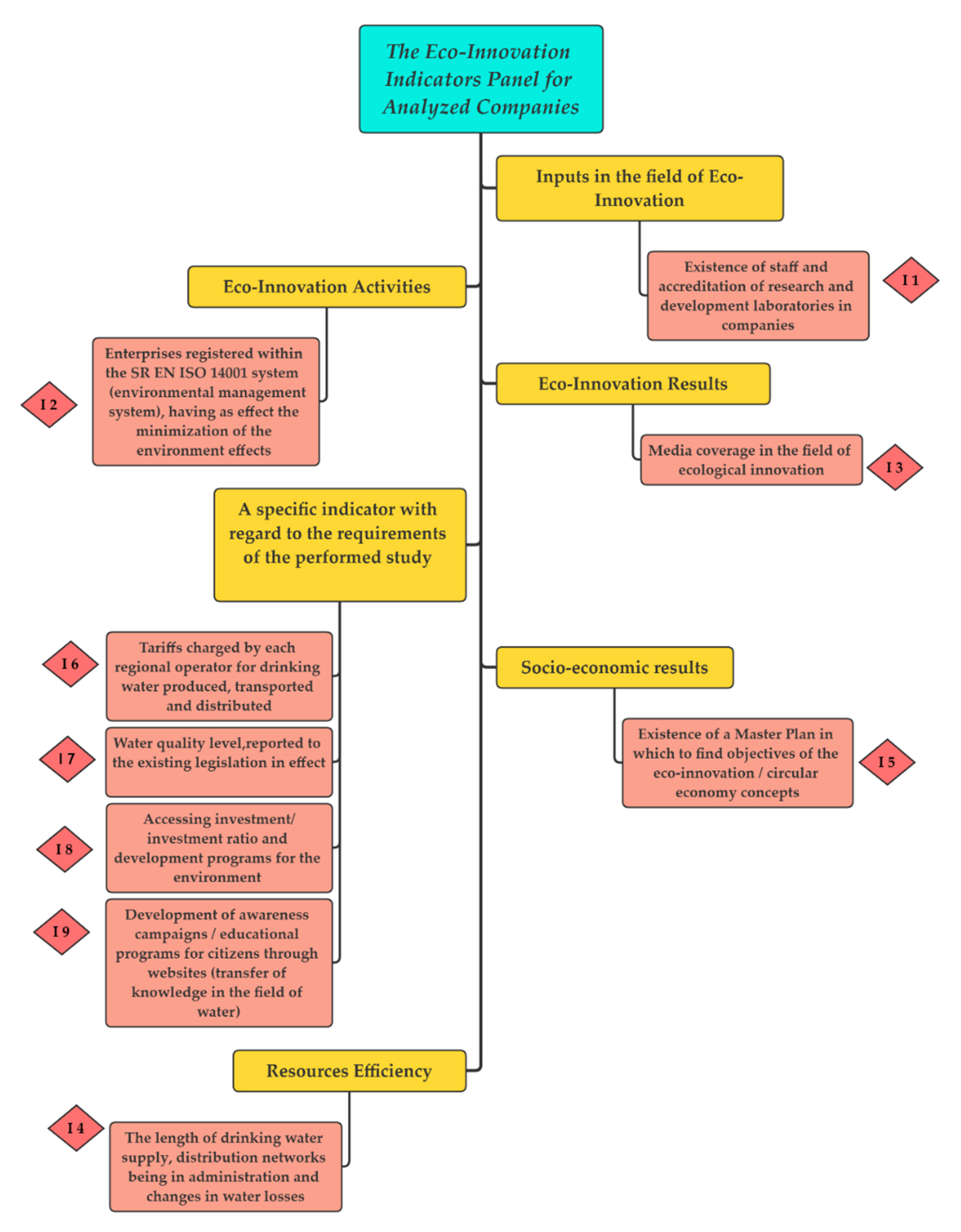
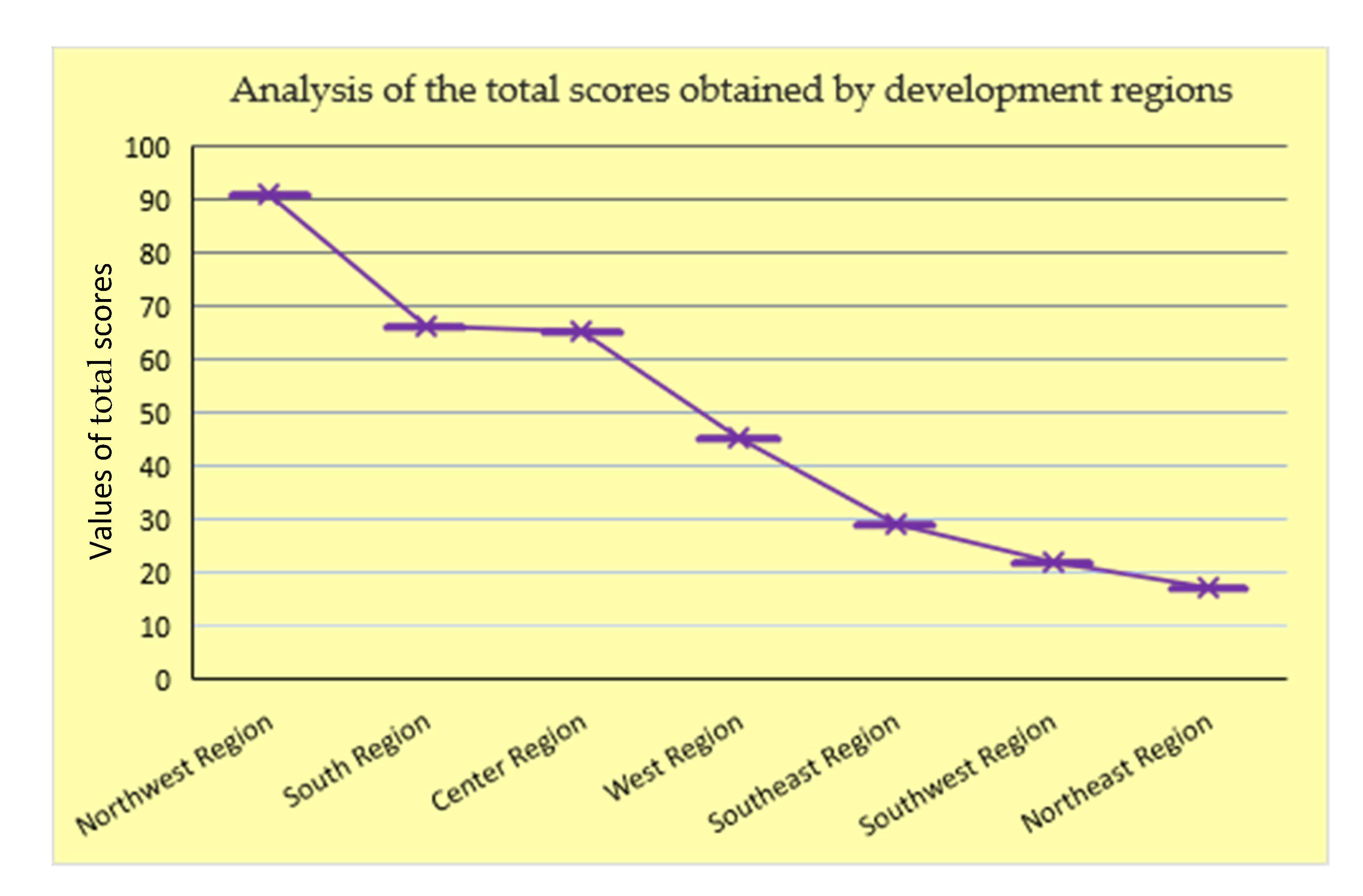
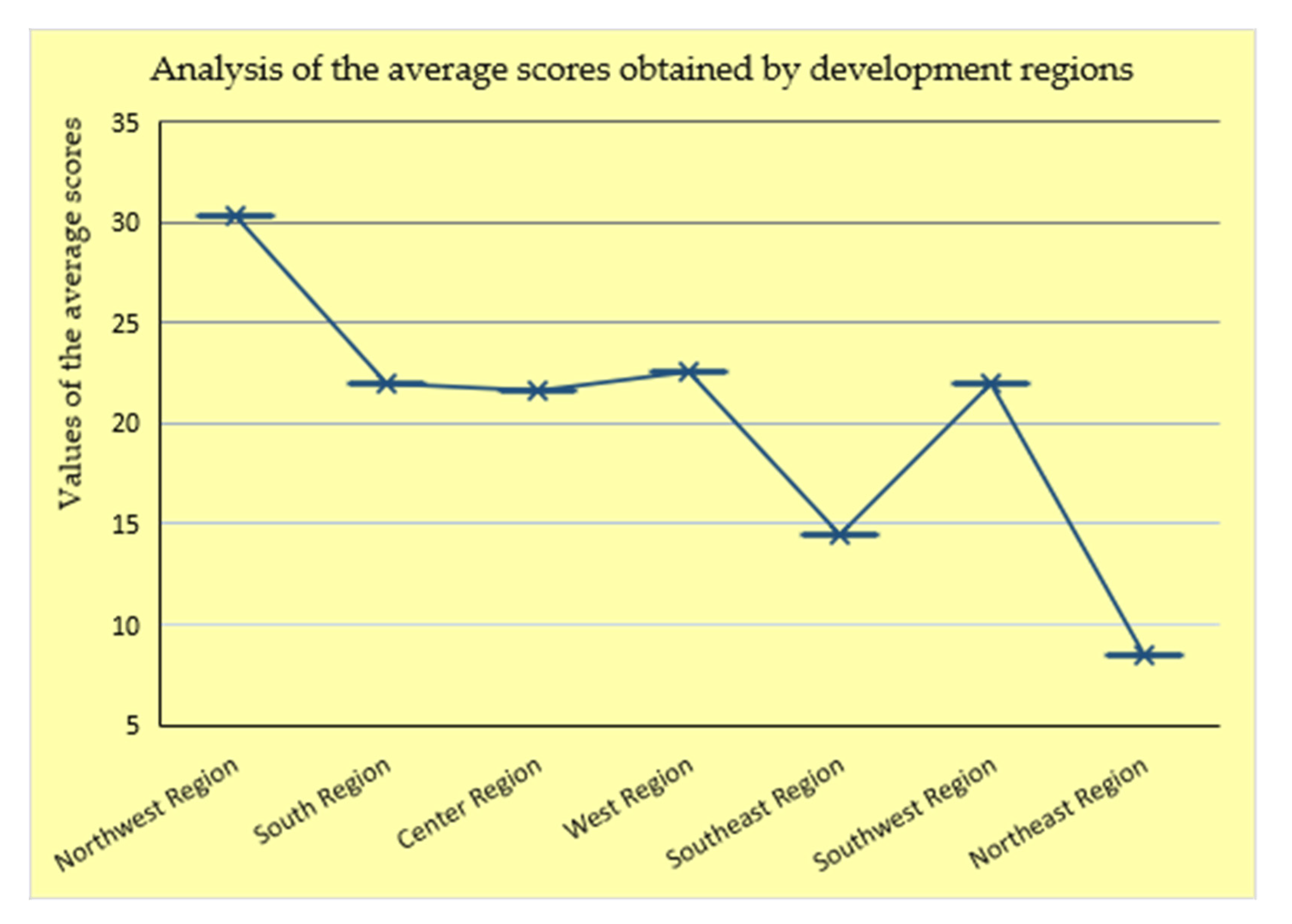
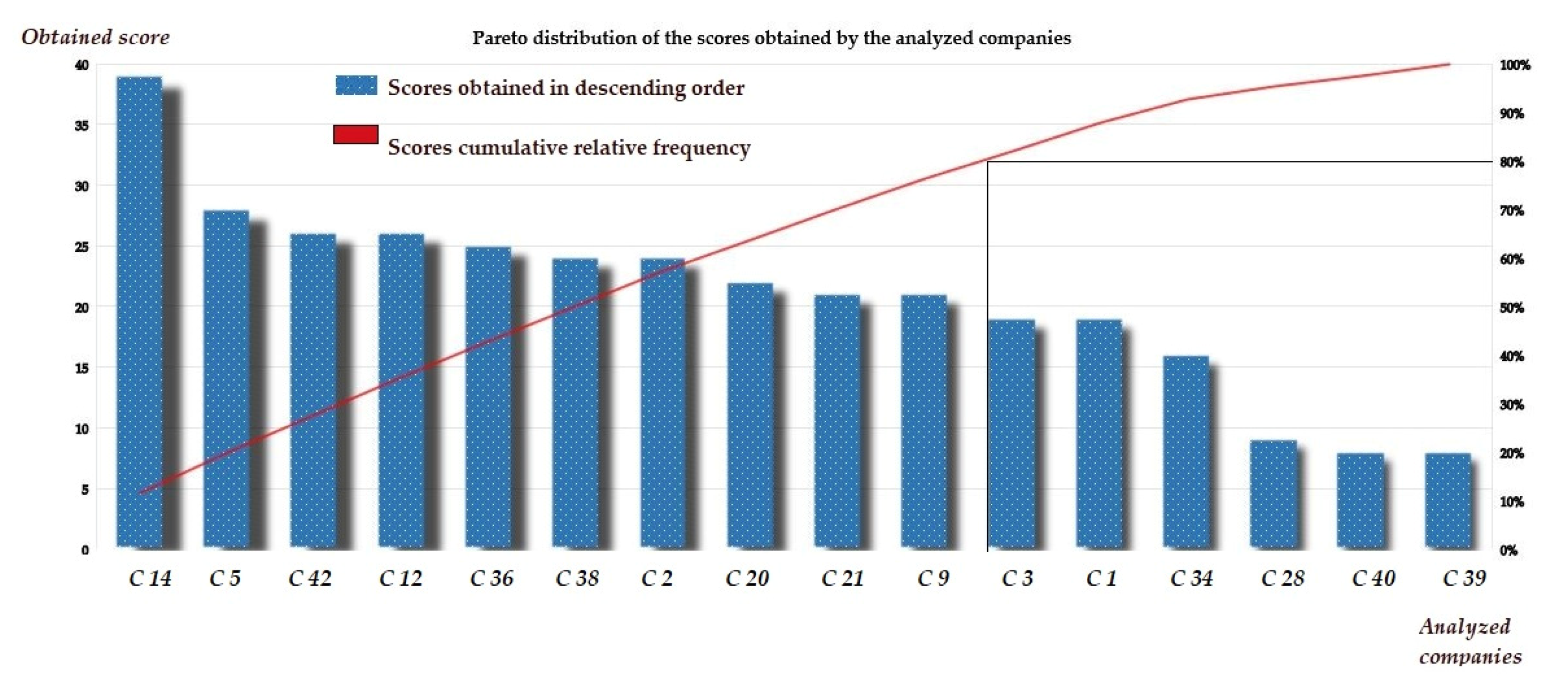
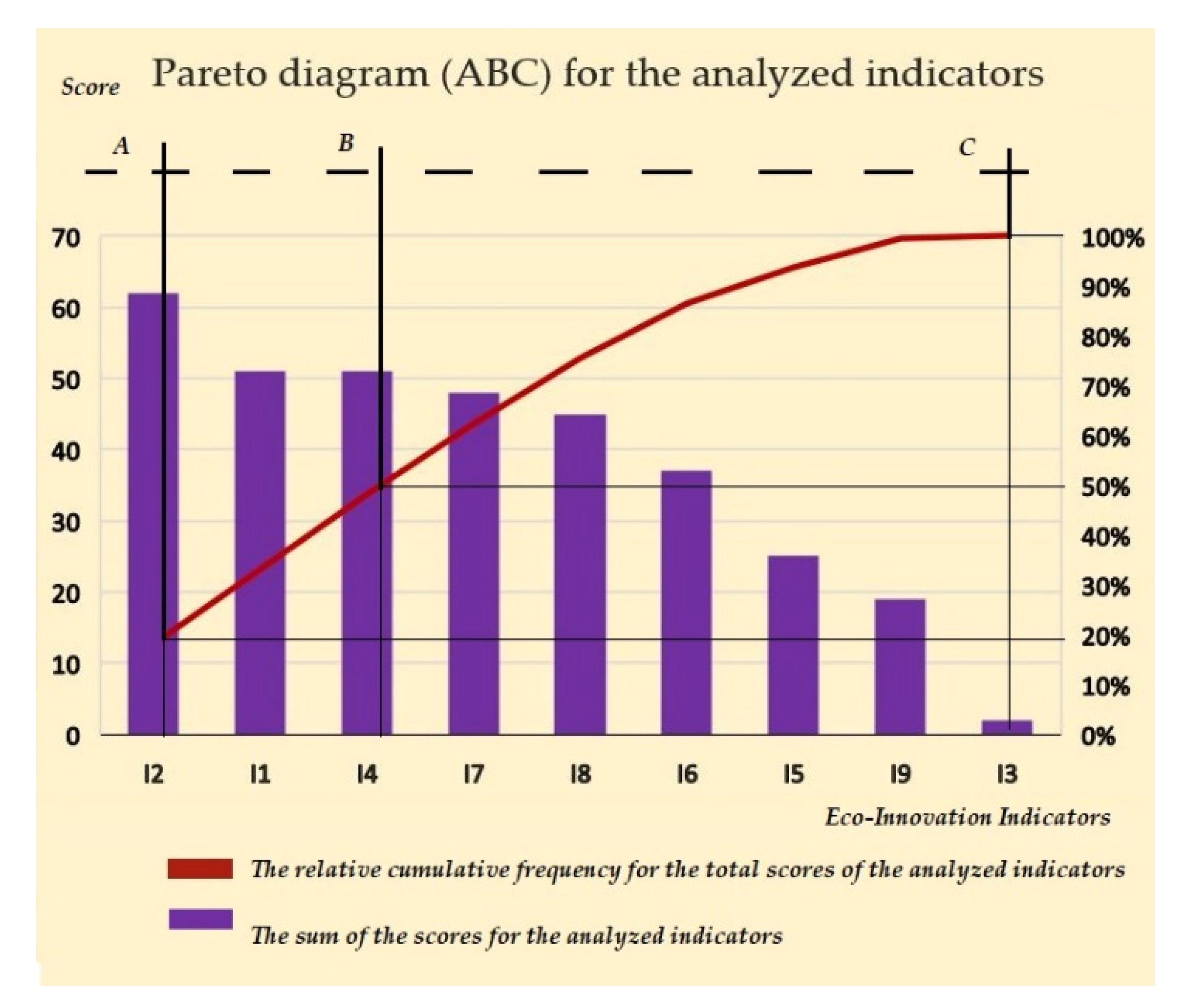
| Indicator Code | Indicator Description |
|---|---|
| I 1 | The fact that there are qualified internal staff and properly equipped research laboratories implied the possibility of continuous monitoring of the quality of the drinking water supplied, but through regular tests and process improvement, based on the knowledge of research staff and innovative methods, and starting from the need for permanent issues faced by the supplier, it was also a measure of the quality of the production process itself. Accreditation of laboratories is performed by the Romanian Accreditation Association (RENAR); the classification was made according to the number of accredited units [34]. For the maximum number of units accredited into a region = 5 p, for a medium number = 3 p, and for a minimum number = 0 p. |
| I 2 | Ensured the implementation of a quality and/or environmental management system (ISO type) certifies compliance with the minimum legal norms (especially ensuring minimal impact on the environment) and allows the identification of the quality level of services and product provided by the distributor. For companies that implemented an integrated management system = 5 p, for companies that implemented only ISO 9001 standard = 3 p, and for companies that did not declare their certification = 0 p. |
| I 3 | Allowed analysis of the results of the company’s promotion activities on increasing its impact on users, both for raising their number, but especially for the quantity of product used by them. For companies that were involved in various promotion campaigns (such as socio-marketing or exposing the refurbishment, presenting the laboratory results or questioning the consumer public) in addition to using several means of mass communication = 5 p, for companies that limited their communication with consumers (formal communication by publishing general data) = 3 p, and among companies disinterested in communication and constantly updating data of public interest = 0 p. |
| I 4 | Allowed the evaluation of the degree of implementation of eco-innovative measures at the drinking water production station level in relation to the area of the drinking water distribution network in order to ensure a more efficient management of resources in terms of their optimization and the rational operation of this distribution network. This indicator covers the entire existing kilometers of water distribution networks of regional operators. Additionally, it covers the changes in water losses from the entire network. Therefore, it does not refer exclusively to cities but refers instead to the entire communities of operators. Operators that registered high performance compared with the established indicator had to accumulate a minimum length of water distribution networks of 1000 km (≥1600 = 5 p); those with average performance were in the length of at least 700–1000 km (>800 = 3 p); low-performance operators fell into the 200–700 km length category (≥200 = 1 p). |
| I 5 | This indicator involved identifying the company’s level of interest in continuous development through the existence of a Master Plan that takes an eco-innovative direction and has socio-economic impact by improving technological equipment, by qualifying and continuously enriching workers’ knowledge, and by employing measures to support ecological and economic efficiency and optics of orientation towards the circular economy, etc. The tie-breaking criterion consisted of the number of objectives specified in the Master Plan for each regional operator: between 6–8 objectives (≥8 = 5 p); 3–5 objectives (>4 = 3 p); 0–2 objectives (≥1 = 1 p). |
| I 6 | This indicator allowed the identification of the pricing regulation level of the product provided in relation to the services offered in order to encourage the large-scale use of drinking water distributed to the population. The price in money/m3 was taken into account. The tariff established for granting the score in accordance with this criterion was represented by the value of the drinking water supply cost expressed in the national currency (RON) related to a volume of 1 m3. The reported price was in accordance with the one declared by the suppliers with the interval between 2.5 and 4 RON on a unit volume of water. The operators that registered high performances compared with the established indicator had to register the following price values: ≤2.85 L/m3 = 5 p; ≤3.44 L/m3 … x … ≥3.30 l/m3 = 3 p; ≥3.78 = 1 p. The tariffs approved and practiced by each regional operator can be found on the National Regulatory Authority for Community Public Utilities Services (ANRSC) website [35]. This indicator was important mainly because all the consumers need to have access to water at a lower price. If this indicator was skipped, consumers would therefore try to buy bottled water, which sometimes is cheaper, but PET waste production would increase. |
| I 7 | By using this indicator, the quality level of drinking water provided by operators could be clearly identified by comparing the values of physical-chemical parameters of drinking water, measured in situ and relating those values to the values imposed by current legislation. For this indicator, physico-chemical parameters were taken into account (mainly the following were taken into account: turbidity, pH, electrical conductivity, hardness, free residual chlorine, ammonium, nitrogen, lead). For the evaluation of operators, the number of non-conformities related to water analyzes at the points chosen for sampling were taken into account. Operators that recorded high performance compared with the established indicator had to have recorded the following values: 0 non-conformities = 5 p; between 1 and 3 non-conformities = 3 p; >3 = 1. |
| I 8 | This indicator also contains investment ratio, which allowed the analysis of the degree of interest in fulfilling the company’s objectives in relation to the need to take measures to improve environmental performance, both through internal actions and by requesting political support through administrative involvement. The indicator of investment and development programs for the environment aimed to highlight the activity of attracting European funds and of involving regional economic operators in the area of environmental protection and modernization in which they carry out their economic activity. In this sense, the degree of access to projects from European funds was pursued with an exclusive focus on the Large Infrastructure Operational Program (POIM) and Sectoral Operational Program (POS)-Environment programs. The evaluation and tie-breaking criteria were as follows:
|
| I 9 | This indicator assessed the degree of communication between supplier and user, specifically communication that had as its special purpose raising users’ awareness of the importance of supporting the environment by using the drinking water provided, communication based on clear evidence of the drinking water quality, and communication following the implementation of a compendium of measures for continuous improvement of the activity and of the obtained and provided product. This indicator aimed to observe the degree of involvement of regional operators in educating and informing citizens, as well as capturing their relationship with the social environment in terms of care for that environment. Depending on the number of the operator’s initiatives, the following classification of the given score was performed:
|
| Indicators | I 1 | I 2 | I 3 | I 4 | I 5 | I 6 | I 7 | I 8 | I 9 | Total Score of Each Company | |
|---|---|---|---|---|---|---|---|---|---|---|---|
| Awarded Score (Between Min 0–Max 5 points) | |||||||||||
| 1. Northwest Region | |||||||||||
| City/Company | C 38 A.S.M | 3 | 5 | 0 | 3 | 0 | 3 | 5 | 5 | 0 | 24 points |
| C 14 C.A.S.C.N. | 5 | 5 | 0 | 5 | 5 | 4 | 5 | 5 | 5 | 39 points | |
| C 5 C.A.O | 5 | 5 | 0 | 4 | 3 | 3 | 5 | 3 | 0 | 28 points | |
| The total region score of 91 points | |||||||||||
| The average region score of 30.33 points | |||||||||||
| 2. West Region | |||||||||||
| City/Company | C 42 S.A.T. | 3 | 5 | 0 | 5 | 0 | 5 | 5 | 3 | 0 | 26 points |
| C 3 C.A.A. | 3 | 5 | 0 | 4 | 0 | 2 | 5 | 0 | 0 | 19 points | |
| The total region score of 45 points | |||||||||||
| The average region score of 22.5 points | |||||||||||
| 3. Southwest Region | |||||||||||
| City/Company | C 20 C.A.O. | 3 | 5 | 0 | 1 | 3 | 2 | 5 | 3 | 0 | 22 points |
| The total region score of 22 points | |||||||||||
| The average region score of 22 points | |||||||||||
| 4. South Region | |||||||||||
| City/Company | C 12 A.N.B | 3 | 5 | 0 | 5 | 1 | 2 | 5 | 0 | 5 | 26 points |
| C 35 H.P.P. | 0 | 2 | 0 | 5 | 3 | 1 | 5 | 0 | 0 | 16 points | |
| C 2 A.C. 2000 | 5 | 5 | 2 | 3 | 1 | 2 | 3 | 0 | 3 | 24 points | |
| The total region score of 66 points | |||||||||||
| The average region score of 22 points | |||||||||||
| 5 Southeast Region | |||||||||||
| City/Company | C 21 A.C.G. | 3 | 5 | 0 | 1 | 3 | 1 | 0 | 5 | 3 | 21 points |
| C 40 A.T. | 0 | 0 | 0 | 1 | 1 | 1 | 0 | 5 | 0 | 8 points | |
| The total region score of 29 points | |||||||||||
| The average region score of 14.5 points | |||||||||||
| 6. Northeast Region | |||||||||||
| City/Company | C 28 A.I. | 3 | 0 | 0 | 4 | 0 | 2 | 0 | 0 | 0 | 9 points |
| C 39 A.S. | 0 | 5 | 0 | 1 | 1 | 1 | 0 | 0 | 0 | 8 points | |
| The total region score of 17 points | |||||||||||
| The average region score of 8.5 points | |||||||||||
| 7. Center Region | |||||||||||
| City/Company | C 1 C.T.T.A. | 5 | 5 | 0 | 2 | 1 | 3 | 0 | 3 | 0 | 19 points |
| C 36 A.C.S. | 5 | 0 | 0 | 5 | 3 | 4 | 5 | 3 | 0 | 25 points | |
| C 9 C.A.B. | 5 | 5 | 0 | 2 | 0 | 1 | 0 | 5 | 3 | 21 points | |
| The total region score of 65 points | |||||||||||
| The average region score of 21.6 points | |||||||||||
Publisher’s Note: MDPI stays neutral with regard to jurisdictional claims in published maps and institutional affiliations. |
© 2021 by the authors. Licensee MDPI, Basel, Switzerland. This article is an open access article distributed under the terms and conditions of the Creative Commons Attribution (CC BY) license (https://creativecommons.org/licenses/by/4.0/).
Share and Cite
Crișan, O.-A.; Bîrleanu, C.; Crișan, H.-G.; Pustan, M.; Merie, V.; Șerdean, F. Eco-Innovation Analyses in the Management of Drinking Water Provided by the Main Suppliers in Romania. Int. J. Environ. Res. Public Health 2021, 18, 6232. https://doi.org/10.3390/ijerph18126232
Crișan O-A, Bîrleanu C, Crișan H-G, Pustan M, Merie V, Șerdean F. Eco-Innovation Analyses in the Management of Drinking Water Provided by the Main Suppliers in Romania. International Journal of Environmental Research and Public Health. 2021; 18(12):6232. https://doi.org/10.3390/ijerph18126232
Chicago/Turabian StyleCrișan, Oana-Adriana, Corina Bîrleanu, Horea-George Crișan, Marius Pustan, Violeta Merie, and Florina Șerdean. 2021. "Eco-Innovation Analyses in the Management of Drinking Water Provided by the Main Suppliers in Romania" International Journal of Environmental Research and Public Health 18, no. 12: 6232. https://doi.org/10.3390/ijerph18126232
APA StyleCrișan, O.-A., Bîrleanu, C., Crișan, H.-G., Pustan, M., Merie, V., & Șerdean, F. (2021). Eco-Innovation Analyses in the Management of Drinking Water Provided by the Main Suppliers in Romania. International Journal of Environmental Research and Public Health, 18(12), 6232. https://doi.org/10.3390/ijerph18126232










